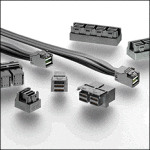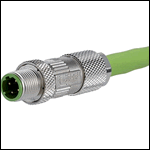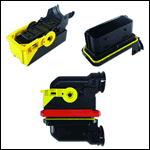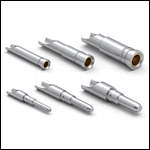A Short Guide to Power Connectors
With such a variety of power connectors from which to choose, C2G has put together a short guide to power connectors to make your selection quick and easy.
Power connectors allow electronic devices to connect to available power outlets. Power cables can carry either alternating current (AC) or direct current (DC). An example of AC power would be power provided by a standard wall outlet in a home or office, while DC power could be provided by a battery. There are several different types of connectors and interfaces that are used all over the world. The power connectors discussed here are some of the more common connectors used in North America.
NEMA 5-15-P
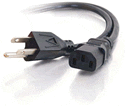 The NEMA 5-15-P is normally referenced as a “three-prong grounded plug,” which plugs into a standard 110VAC wall outlet. “NEMA” stands for the National Electrical Manufacturers Association, which sets standards for use in electrical products. The connector has two flat parallel blades, with a round ground pin located between and above them. The female mating outlet for the 5-15-P is called a 5-15-R (for “receptacle”).
The NEMA 5-15-P is normally referenced as a “three-prong grounded plug,” which plugs into a standard 110VAC wall outlet. “NEMA” stands for the National Electrical Manufacturers Association, which sets standards for use in electrical products. The connector has two flat parallel blades, with a round ground pin located between and above them. The female mating outlet for the 5-15-P is called a 5-15-R (for “receptacle”).
NEMA 1-15-P
 The NEMA 1-15-P is normally referenced as a two-prong plug that fits into a standard 110VAC wall outlet. It has two flat blades, just like the NEMA 5-15 plug, but has no ground pin. The female mating outlet for the 1-15-P is called a 1-15-R. Most current versions of this plug have one blade slightly wider than the other.
The NEMA 1-15-P is normally referenced as a two-prong plug that fits into a standard 110VAC wall outlet. It has two flat blades, just like the NEMA 5-15 plug, but has no ground pin. The female mating outlet for the 1-15-P is called a 1-15-R. Most current versions of this plug have one blade slightly wider than the other.
IEC 320 C13/C14
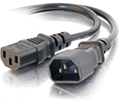 The IEC 320 C13/C14 connectors are based on standards created by the International Electrotechnical Commission, an international standards body. The “320” refers to the specification for power connectors (the standard is actually numbered 60320, but common usage shortens it to 320). The C13 line socket is very common in the PC and A/V industries. The mating connector for the C13 socket is the C14 plug, which is often mounted into a recessed panel or chassis on computer power supplies or power transformers.
The IEC 320 C13/C14 connectors are based on standards created by the International Electrotechnical Commission, an international standards body. The “320” refers to the specification for power connectors (the standard is actually numbered 60320, but common usage shortens it to 320). The C13 line socket is very common in the PC and A/V industries. The mating connector for the C13 socket is the C14 plug, which is often mounted into a recessed panel or chassis on computer power supplies or power transformers.
IEC 320 C5
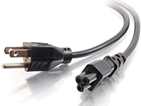 IEC 320 C5 is a polarized power socket often found on the power supplies used by notebook computers. The C5 connector has three round prongs arranged in a triangular fashion. One common slang term for this plug is “Mickey Mouse ears connector,” because the shape resembles the silhouette of Disney’s cartoon character.
IEC 320 C5 is a polarized power socket often found on the power supplies used by notebook computers. The C5 connector has three round prongs arranged in a triangular fashion. One common slang term for this plug is “Mickey Mouse ears connector,” because the shape resembles the silhouette of Disney’s cartoon character.
IEC 320 C7 (Non-Polarized)
 IEC 320 C7 (non-polarized) is a two-prong connector used on power transformers, radios, and other consumer electronic devices. It has two rounded prongs side by side.
IEC 320 C7 (non-polarized) is a two-prong connector used on power transformers, radios, and other consumer electronic devices. It has two rounded prongs side by side.
IEC 320 C7 (Polarized)
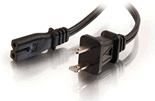 IEC 320 C7 (polarized) is a polarized version of the C7 socket. The polarization of this connector is maintained by the squarish shape of the overmold on the one end of the socket. This design ensures that the neutral side of the device is always connected to the neutral wire of an AC circuit (which is normally shorted to ground in a two-wire outlet).
IEC 320 C7 (polarized) is a polarized version of the C7 socket. The polarization of this connector is maintained by the squarish shape of the overmold on the one end of the socket. This design ensures that the neutral side of the device is always connected to the neutral wire of an AC circuit (which is normally shorted to ground in a two-wire outlet).
CEE 7/7
 CEE 7/7 is a plug designed for use primarily in Europe. It has a round shape with two rounded pins and a socket that accepts the grounding pin from a “Type F” European wall outlet. CEE is the abbreviation for the International Commission on Rules for the Approval of Electrical Equipment, a European standards body.
CEE 7/7 is a plug designed for use primarily in Europe. It has a round shape with two rounded pins and a socket that accepts the grounding pin from a “Type F” European wall outlet. CEE is the abbreviation for the International Commission on Rules for the Approval of Electrical Equipment, a European standards body.
